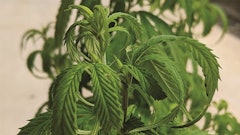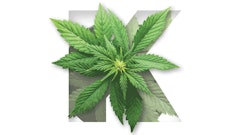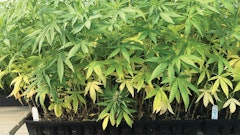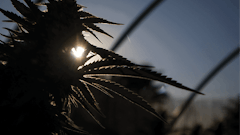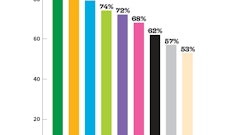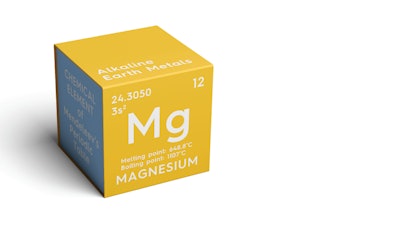
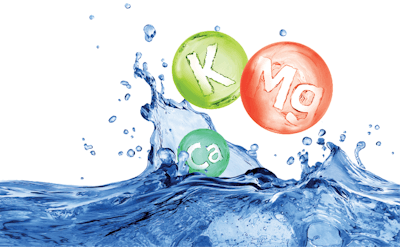
Magnesium (Mg) is sometimes a forgotten element.
In the many areas of North America that rest on limestone bedrock, adequate Mg is available in the groundwater used for irrigation. Concentrations of 25 to 50 ppm Mg are often available and provide adequate levels for plant growth for most plant species. In addition, supplemental Mg is also supplied via the dolomitic limestone used to adjust the substrate pH. But not all growing locations are blessed with a supply of Mg.
Magnesium deficiencies can occur due to a number of factors. In areas without Mg in the irrigation water, of course the free Mg source is lacking. We have observed in these locations with floriculture species that the level of Mg supplied by the dolomitic limestone will provide adequate levels of Mg through 50 percent to 75 percent of the season. After that time, leaf symptoms begin to develop. This is especially true during warm springs when the plants are irrigated more frequently and the Mg is most likely leached from the substrate.
For cannabis, it is common to observe mother stock plants exhibiting this symptomology. This may be because the mother plants typically have a larger root system, and consequently, these plants have a higher water demand. Thus, the increased amount of irrigation applied to these plants may cause excess leaching of Mg from the substrate, resulting in the interveinal chlorosis we encounter on a regular basis in mother stock operations.
Magnesium uptake is also affected by the presence of other elements. In general, a nutrient balance is obtained by targeting a 4:2:1 ratio of potassium (K) to calcium (Ca) and Mg. This helps avoid antagonisms among these elements. For example, if one element is excessive in the nutrient solution, then that can limit the plant’s ability to uptake adequate levels of the other two nutrients. Antagonistic situations commonly are observed with crops such as tomatoes, in which high levels of Ca are provided to avoid blossom end rot, or with geraniums, in which high levels of dolomitic limestone or flowable lime are added to avoid a substrate pH drop. Elevated levels of Ca limit the uptake of Mg, and these plants often develop deficiency symptoms.
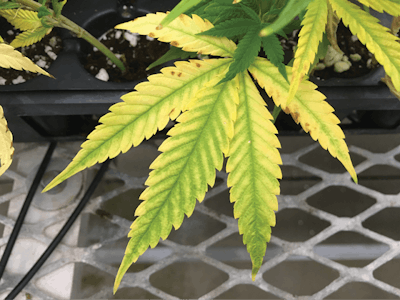
Magnesium Deficiency Symptoms
Cannabis (Cannabis sativa) plants often develop interveinal chlorosis (yellowing) on the lower leaves (Fig. 1). A few areas of the leaves develop a slight interveinal chlorosis (Fig. 2a), which expands over time (Fig. 2b). With advanced symptoms, necrotic (brown) spotting will develop (Fig. 2c). These symptoms are associated with Mg deficiency. Symptoms have been observed in greenhouses in locations without Mg in the irrigation water supply as one would expect, but it is also common to observe symptomology in areas with moderate levels of Mg in the water. This leads to the conclusion that cannabis, similar to tomatoes and poinsettias, has a higher demand for Mg than most plant species. In general, the Mg leaf tissue sufficiency range for cannabis is between 0.40 percent to 0.81 percent, as suggested by Bryson and Mills in the “Plant Analysis Handbook IV.”

Corrective Procedures
The fix for a Mg deficiency is easy. Epsom salts (magnesium sulfate) can be applied at the rate of 2 pounds per 100 gallons of water (2.4 kg/1000L). Apply this as a 5 percent to 10 percent flow-through leaching irrigation. This will stop the progression of symptoms, but will not reverse any interveinal leaf chlorosis or necrotic spotting. For areas that lack sufficient Mg in their irrigation water, and Mg is not part of the regular fertilization program (i.e., 20-10-20 does not contain Mg), monthly applications of Epsom salts at the rate of 1 pound per 100 gallons of water (1.2 kg/1000L) is the common production practice to green up plants and avoid deficiencies. (Also, note that mixing Epsom salts with Ca-based fertilizers will result in an insoluble precipitate forming in the fertilizer container, and should be avoided.)
Conclusions
Symptoms of Mg deficiency readily develop on cannabis because, as noted earlier, cannabis has a higher demand for Mg than most other species. Therefore, growers may need to increase the amount of Mg available from the irrigation water by providing supplemental Mg to the plants as needed to avoid the development of deficiency symptoms.













